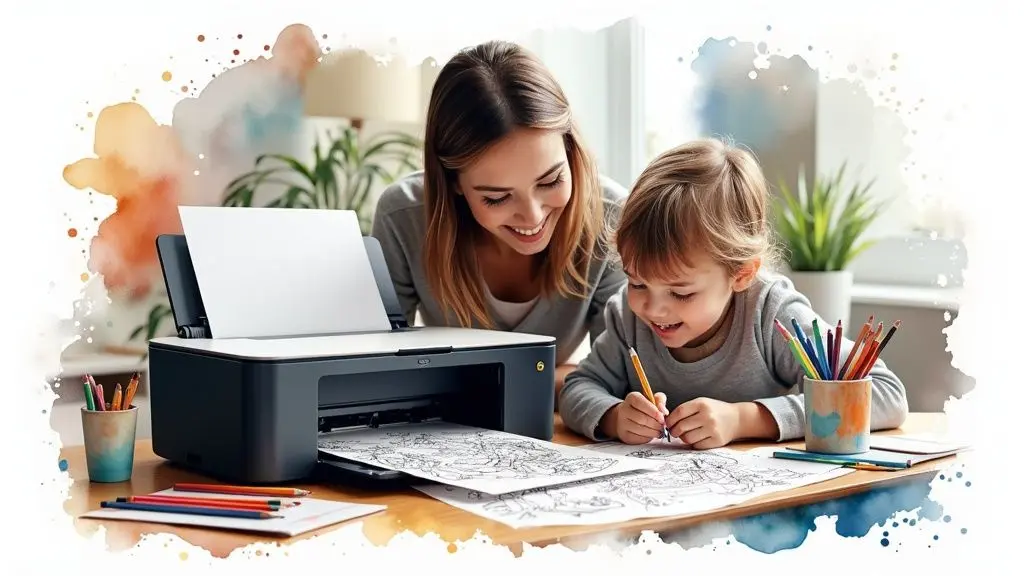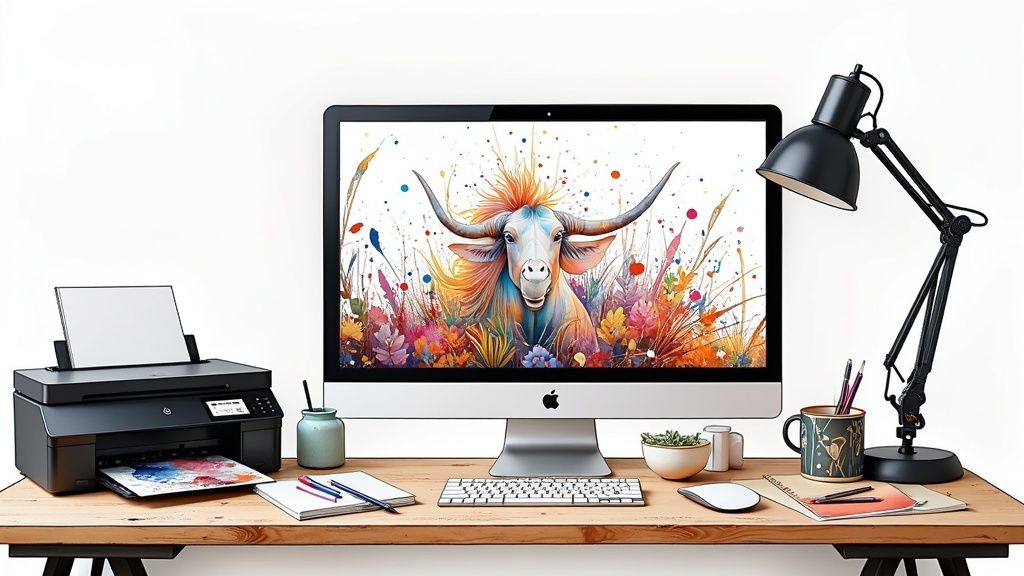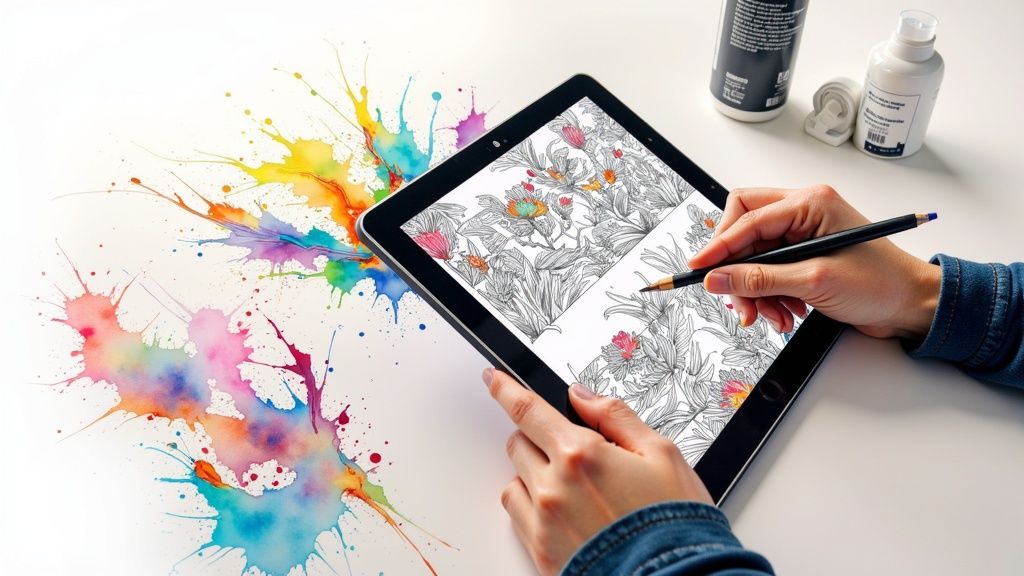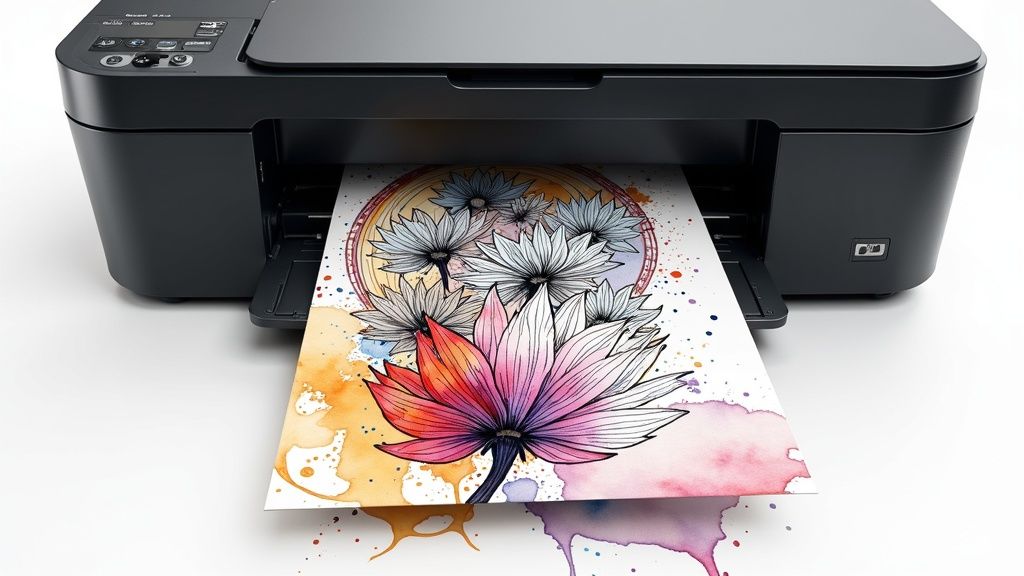How to Print Coloring Pages: A Complete Guide for Perfect Results Every Time
January 29, 2025

Essential Equipment and Setup for Professional Results
Getting started with creating high-quality coloring pages means having the right gear and setup. The good news is, you don't need complex equipment - just thoughtful choices in a few key areas.

Selecting the Ideal Printer
Your printer choice makes a big difference in the final product. Here's what to consider:
- Inkjet vs. Laser: Go with inkjet for vivid colors, or laser for quick, cost-effective black and white prints
- Print Quality: Look for 1200 DPI or higher for sharp, clear images
- Extra Features: Consider options like eco-modes or wireless printing for easier use
Recent data shows more people are printing at home than ever - printer sales jumped 12% during the pandemic as home offices became the norm. Check out more details in these printing industry statistics.
Understanding Paper and Mediums
The paper you choose affects how well your coloring pages turn out:
- Paper Weight: Thicker papers like cardstock work best - they prevent markers from bleeding through and hold up to repeated use
- Surface Texture: Match your paper to your coloring tools - smooth for fine details, textured for colored pencils
Try out different paper types to see what works best for your specific projects and tools.
Organizing Your Workspace
A clean, well-organized space helps you work better:
- Storage Solutions: Set up shelves or drawers to keep supplies easy to find
- Comfortable Setup: Position your desk and chair for good posture during long sessions
Budget-Friendly Tips
You can get great results without spending too much:
- Refurbished Equipment: Save money on printers while still getting reliable quality
- Buy Smart: Stock up on supplies when they're on sale or available in bulk
Remember - it's not about having the most expensive setup. Focus on choosing reliable tools that fit your needs and budget. When you have the right basics in place, you're ready to create beautiful coloring pages consistently.
Discovering and Curating Quality Coloring Resources
Finding great coloring pages can truly enhance your coloring experience. Whether you prefer free or paid options, knowing how to find and evaluate quality resources will help you build an inspiring collection.

Evaluating Coloring Page Quality
The quality of your coloring pages directly impacts your final results. Here's what to look for:
- Resolution: Choose pages with 300 DPI or higher for sharp, clear prints
- File Types: PNG and PDF formats provide the best quality and easy sizing
- Line Quality: Pick pages with smooth, clean lines without fuzzy edges or pixels
Organizing Your Digital Library
A well-organized collection makes it easy to find the perfect page when inspiration strikes:
- Theme-Based Filing: Sort pages into categories like nature, mandalas, or characters
- Digital Management: Use tools like Adobe Lightroom to tag and sort your collection
- Regular Backups: Save your library to cloud storage to protect your collection
Want to get more from your coloring? Check out our guide on how to master the art of coloring.
Tips for Finding Quality Sources
Building a great collection starts with finding reliable sources:
- Community Reviews: Read user feedback about download quality and experiences
- Connect with Artists: Follow your favorite creators for early access to new designs
- Check Rights: Make sure you have permission to use and print the pages
Understanding Technical Details
Getting the technical aspects right ensures beautiful prints every time:
- Size vs Quality: Find the sweet spot between file size and print quality
- Protection: Add watermarks to shared pages to protect original artwork
- Usage Rights: Review and follow creators' terms of use guidelines
These strategies will help you build and maintain a diverse collection of coloring pages that inspire your creativity and bring joy to your coloring practice.
Mastering Printer Settings for Flawless Output

Getting great coloring pages starts with dialing in your printer settings. Just like an artist needs the right tools, your printer needs the right settings to produce crisp, clean pages that are perfect for coloring. Let's look at how to get the best results from your home printer.
Understanding Basic Print Settings
Your printer has several key settings that work together to create the final print. Think of these as the building blocks for perfect coloring pages - each one plays an important role in the end result.
- Print Quality: Choose between "Draft" to "Best" quality. For coloring pages, pick "Best" quality to get sharp, clear lines. While this uses more ink, the clean results make it worthwhile.
- Paper Type: Tell your printer what paper you're using. If you're using thicker paper, select "Cardstock" to prevent ink bleeding through.
- Color Settings: Even for black and white pages, adjusting these settings helps. Making the black ink darker creates bolder outlines that are easier to color within.
Advanced Color Management Techniques
If you want to take your printing to the next level, understanding color management can help. This is especially useful for color-by-number pages or creating your own designs.
- Color Profiles: These are like instruction sets that tell your printer exactly how to mix and lay down colors. Using the right profile means your colors will look exactly as intended.
- Calibration: Getting your printer and screen to show the same colors takes some setup, but leads to more accurate prints. This helps ensure what you see is what you get.
Optimizing for Different Coloring Tools
Each coloring tool needs slightly different paper and print settings for best results:
- Markers: Use thicker paper settings and higher print quality. This helps prevent markers from bleeding through and gives you a solid base for coloring.
- Colored Pencils: Paper with some texture works best - it grips the pencil and prevents smudging. Try a few different paper types to find what works best.
- Watercolors: If you plan to use watercolors, print with lighter settings. This keeps the paper from getting too wet when painting.
Printer-Specific Tips
Every printer model works a bit differently. Your printer's manual and the manufacturer's website can give you specific tips for getting the best results.
- Brand Resources: Major brands like Epson, Canon, and HP offer detailed guides for optimizing print quality.
- Problem Solving: These resources also help fix common issues like uneven printing or color problems that might affect your coloring pages.
Taking time to master your printer settings pays off with better coloring pages. Try different combinations of settings and paper types until you find what works best for your favorite coloring tools. The right setup makes coloring more enjoyable and helps your artwork look its best.
Customizing Formats for Every Age and Skill Level

Getting your coloring pages just right means thinking about who will be using them. Whether you're printing for toddlers just learning to color or experienced artists seeking a challenge, a few simple adjustments can make all the difference. Let's look at how to create the perfect coloring experience for every age and ability level.
Adapting Pages for Different Age Groups
Little ones need plenty of space to color without getting frustrated. Simple designs with thick, bold outlines work best for developing those early coloring skills. A basic sun or flower gives toddlers confidence, while elementary school kids might enjoy coloring their favorite cartoon characters.
For older kids and teens, try more detailed designs that match their interests and abilities. A middle schooler might love coloring realistic animals, while high schoolers could get lost in geometric patterns. Want more ideas? Check out our complete guide to adult coloring books for inspiration.
Maintaining Image Quality While Resizing
Clear, crisp lines make coloring more enjoyable at any age. When you resize a coloring page, start with high-quality images - 300 DPI or higher gives the best results. If your image looks fuzzy after resizing, try using basic photo editing tools to sharpen the lines and smooth out rough edges.
Creating Appropriate Margins
Don't forget about margins! Good margins give kids space to hold their paper without smudging their work. This small detail makes a big difference, especially for younger children still working on their coloring skills. Leave at least a half-inch margin around the edges - even more for preschoolers.
Managing Complex Designs for Advanced Colorists
More experienced colorists often enjoy intricate designs that take time and focus to complete. Detailed mandalas, nature scenes, and abstract patterns let them show off their coloring techniques. These complex pages can provide hours of relaxing, creative fun.
By taking time to match the design to the person, you'll create coloring pages that are both fun and fulfilling. The right format turns coloring from a simple activity into an engaging experience that grows along with the artist's skills.
Creating Professional-Grade Coloring Projects
Great coloring projects require attention to detail and the right techniques. By focusing on key elements like paper quality, design cohesion, and personal touches, you can create polished coloring books that stand out. Here's how to take your coloring pages from basic to professional.
Developing Custom Coloring Books
A successful coloring book starts with a clear vision and organized approach. Begin by choosing a theme that tells a story - whether it's an ocean adventure or a collection of geometric patterns. Here's what to consider:
- Theme Development: Pick a core concept that connects all pages naturally
- Design Balance: Mix simple and complex designs to appeal to different skill levels
- Digital Creation: Use Adobe Photoshop for crisp linework or try ColorPageAI for unique designs
For a professional finish, look into binding options. Spiral binding works well for lay-flat coloring, while perfect binding gives a classic book feel. Double-sided printing saves paper while maintaining quality when done properly.
Specialty Paper Printing
The right paper makes a big difference in the final product. Watercolor paper, for example, lets artists use wet media without damaging the page. Consider these paper options:
- Cardstock: Strong enough for markers and colored pencils without bleeding
- Glossy Paper: Shows off bright colors and detailed designs clearly
- Textured Paper: Perfect for adding depth with dry media like pastels
Getting the best results means adjusting your printer settings for each paper type. Learn more in our guide on How to master printer settings for coloring.
Adding Personal Touches
Small details can make your coloring pages special and unique. Try these creative additions:
- Custom Borders: Add decorative edges using physical or digital tools
- Written Elements: Include names, dates, or meaningful quotes
- Color Schemes: Use specific color palettes to tie pages together
A clear protective cover not only keeps pages safe but also gives your project a store-quality look. This final touch makes your coloring book perfect for sharing with others or selling.
By focusing on these key areas, you'll create coloring projects that look and feel professional. The combination of thoughtful design, quality materials, and careful finishing turns simple coloring pages into something special.
Solving Common Challenges and Maintaining Quality
Printing coloring pages doesn't have to be complicated, but it does require attention to a few key details. Let's look at common issues and practical solutions that will help you create beautiful prints consistently. With some basic troubleshooting knowledge and regular maintenance, you can avoid frustrating problems and keep your printer running smoothly.
Troubleshooting Common Printing Issues
Paper jams happen to everyone, but they're usually easy to prevent. The key is using the right paper - cardstock tends to work best for coloring pages since it's sturdy enough to handle ink without warping. If you notice frequent jams, take a quick look at your printer's rollers. A bit of dust buildup is normal, but cleaning it off can make a big difference.
Getting your printed colors to match what you see on screen can be tricky at first. Most printers come with built-in tools to help adjust your color profiles and calibration. Take a few minutes to run through your printer's color setup process - this small step can save hours of frustration with mismatched colors later.
Conducting Preventive Maintenance
Taking care of your printer doesn't require special skills, just consistency. Here are the basics that make a big difference:
- Clean Printer Heads: Use a soft cloth with isopropyl alcohol to gently clean the heads once a month
- Watch Ink Levels: Keep an eye on your printer's ink alerts to avoid running dry mid-project
- Regular Testing: Use your printer's built-in diagnostic tools to check alignment and performance
Achieving Professional Results on a Budget
You don't need expensive equipment to create great coloring pages. Here are some smart ways to save money while getting excellent results:
- Generic Ink Cartridges: Many off-brand inks work just as well as name brands at half the price
- Free Design Tools: Photopea offers professional-grade editing features without the cost
These simple steps help ensure your coloring pages turn out beautifully every time. Regular maintenance and smart choices about supplies keep printing affordable and hassle-free.
For more help creating and printing perfect coloring pages, check out ColorPage.AI. It offers options for everyone from kids just starting out to experienced artists looking for complex designs.
Ready to start coloring?
Join ColorPage.ai today and get 5 free credits to create your own custom coloring pages!
Start creating